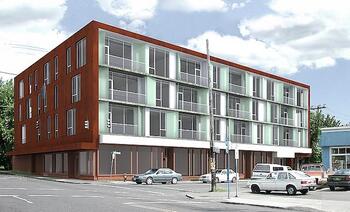
Many surveys have found that the vast majority of Americans, including Millennials, prefer or aspire to live in single-family homes. But surveys rarely ask whether they prefer that single-family home to be in a low-density neighborhood or if they would mind living next to a bunch of apartment buildings.
Would you want a mid-rise condo building to move next-door to your single-family home? This is real affordable housing, by the way: one of these condos (shown in lead photo) is currently selling for $527 per square foot.
However, a polling firm called YouGov recently asked Americans whether they thought low-density neighborhoods were better than high-density ones. Specifically, they were asked whether low densities meant more or less congestion, more or less crime, and were better or worse for the environment. Planning advocates, of course, claim that high densities mean less congestion, are better for the environment, and have less crime because there are more “eyes on the street.”
Those density advocates apparently haven’t been able to persuade most Americans that densities are better. According to the survey, 75 percent of Americans think that low densities are better for the environment, 60 percent think low-density neighborhoods are less congested, and 62 percent think they suffer less crime. I happen to agree with the majority on all three points, but whether you agree or not, it is clear that most Americans want to live, not just in single-family homes, but in low-density neighborhoods.
The survey also asked another question: should people be free to buy land and develop it as they please or should the government limit where they can build things? A smaller majority, 55 percent, believed people should be free to develop real estate as they please. Does that mean they oppose single-family zoning? Or does it mean they oppose restrictions on rural development?
Developers learned in the 1890s that Americans would more readily buy homes if the properties they bought, and their neighbors, were deed-restricted to have nothing more than single-family homes. Zoning was developed in the early 1900s to emulate deed restrictions in single-family neighborhoods that had been built before the widespread use of deed restrictions. This gave people confidence that their neighborhood densities would remain low and, as a result, urban homeownership rates increased by 150 percent by 1930.
Read the rest of this piece on The Antiplanner.
Randal O'Toole, the Antiplanner, is a policy analyst with nearly 50 years of experience reviewing transportation and land-use plans and the author of The Best-Laid Plans: How Government Planning Harms Your Quality of Life, Your Pocketbook, and Your Future.
Photo: courtesy The AntiPlanner.












